Anatomy Class Notes Chapters 1-4
Introduction to Human Anatomy and Physiology
Gross anatomy - seen with the naked eye
Microscopic anatomy - needs a microscope
Physiology - the study of function
dictates the structure
Anatomy - the study of structure
form will follow function
Levels of Structural Organization
Chemical
atoms
Cellular
basic level of life
Tissue
multiple cells
Organ
multiple tissues
Organ System
multiple organs
Organism
organ systems working together
Organ Systems Examples
nervous
endocrine
integumentary
skeletal
muscular
circulatory
lymphatic/immune
respiratory
digestive
urinary
reproductive
Characteristics of Life
maintaining boundaries - mouth, skin
responsiveness - sense and respond to stimuli
adaptability - change with the environment
growth and reproduction - increase in size and number of organisms
movement - intended change in location or position
digestion - breakdown of food into simpler structures for absorption into the bloodstream
metabolism - chemical reactions of a cell
respiration - absorption and use of respiratory gases
circulation - fluid movement within the organism
excretion - removal of chemical waste
Requirements of Human Life
oxygen
nutrients
temperature range
atmospheric pressure
Homeostasis
a state of equilibrium or balance within the body
vital for survival
feedback mechanisms: receptors, control centers, effectors
negative - reduce the original stimulus
body temperature
positive - accelerates a process to competition by intensifying the original stimulus
blood clotting
Abdominopelvic Quadrants and Regions
Quadrants
RUQ
LUQ
RLQ
LLQ
Regions
right hypochondriac
epigastric
left hypochondriac
right lumbar
umbilical
left lumbar
right iliac
hypogastric
left iliac
Anatomical Terminology
Directional Terms
other parts of the body
Sectional Terms
planes
Regional Terms
Anatomical Position ****
always patient left and right
Body Cavities
Dorsal
cranial
vertebral
Ventral
thoracic
abdominopelvic
Medical Imaging Techniques
x-ray - uses electromagnetic radiation to create images of dense body structures
computed tomography scan (CT) - combines multiple x-ray images to create detailed cross-sectional views
magnetic resonance imaging (MRI) - uses magnetic fields and radio waves to produce detailed images of soft tissues
positron emission tomography scan (PET) - uses a short-lived radioactive contrast that will travel to areas with high metabolic activity such as cancer
ultrasound - uses high-frequency sounds waves to create real time images of internal structures
The Chemical Level of Organization
Atomic Structure
atom
smallest unit of an element
subatomic particles
protons, neutrons, electrons
atomic number
number of protons
identifies the element
isotopes = ±neutrons relative to base protons
Electron Behavior
electron shells - layers around the nucleus at distinct energy levels
first only holds 2 electrons
valence shell - outermost shell
determines chemical reactivity
octet rule - 8 electrons in the valence shell
most stable at completion
Ionic Bonds
Formation - atoms donate or accept electrons
become charged ions (electrolytes)
unstable
attraction - opposite charges of cations and anions create attraction
example - table salt: Na+ and Cl- ions strongly attract
positive charge when loses an electron
negative charge when accepts an electron
Covalent Bonds
Electron sharing - atoms share electrons in valence shell
types:
polar - equal sharing
non-polar - unequal sharing
Example:
water - polar covalent bonds between oxygen and hydrogen
carbon dioxide - non-polar
Stable
Hydrogen Bonds
weak attraction between polar molecules
formation: weakly positive hydrogen attracted to electronegative atom
water molecules
Energy in Chemical Reactions
Kinetic energy - energy of motion that powers chemical reactions
Potential energy - stored energy in chemical bonds
Exergonic (Catabolic) Reactions - release more energy than they absorb
Endergonic (Anabolic) Reactions - absorb more energy than they release
Types of Chemical Reactions
Synthesis - smaller components join to form larger molecules
requires energy, anabolic
A+B=AB
Decomposition - breakdown of larger molecules
released stored energy, catabolic
AB = A + B
Exchange - both synthesis and decomposition occur
bond are formed and broken
anabolic and catabolic
Factors Influencing Reactions
Temperature
higher temp = increase reaction rate from increased particle motion
Concentration
higher concentration of reactant increases collision frequency
Enzymes
catalysts that lower activation energy and speed up reactions
Water: The Universal Solvent
Makes up 70% of an adults body weight
Lubricant - joints and aids digestion
Cushion - protects organs from physical trauma
Heat sink - water absorbs heat without greatly increasing in temperature
Salts: Ionic Compounds
Salts dissociate into ions in water, crucial for nerve impulses and muscle contraction
NaCl = table salt
CaHCO3 = Calcium Carbonate (Tums)
Acids and Bases: pH Regulators
Acids release hydrogen ions (H+) in solution
Bases release hydroxyl ions (OH-) or accept H+
<7 acids
7 neutral
>7 bases or alkaline
p - partiality
The Chemistry of Carbon
Carbon - four electrons in valence shell
Covalent Bonds - shared electrons between atoms
Functional Groups - atoms that function as a unit
Carbohydrates
Monosaccharides
single sugar units like glucose, fructose, and galactose
Disaccharides
pairs of monosaccharides like sucrose, lactose, and maltose
Polysaccharides
long chains of monosaccharides like starch, glycogen, and cellulose
Lipids
hydrophobic compounds made of mostly hydrocarbons
provide energy, cell membrane structure, and signaling molecules
triglycerides
major fuel source, composed of glycerol and fatty acids
phospholipids
cell membrane components with hydrophobic tails and hydrophilic hairs
steroids
four-ring structures like cholesterol, important for hormones
Prostaglandins
signaling molecules derived from unsaturated fatty acids
Amino Acids
structure
have a central carbon atom bonded to a hydrogen, an amino group, a carboxyl group, and a variable side chain
bond
amino acids join via dehydration synthesis to form peptide bonds, creating polypeptides and proteins
essential amino acids
nine essential
cannot be synthesized by the body and must be consumed in the diet
Protein Structure and Shape
primary structure
the sequence of amino acids in the polypeptide chain
secondary structure
folding patterns like alpha-helices and beta-pleated sheets, maintained by hydrogen bonds
tertiary structure
three-dimensional shape formed by further folding and bonding of a secondary structure
quaternary structure
interactions between two or more tertiary subunits, as in hemoglobin
Protein Functions in the Body
structural support
collagen
enzymes
catalyze chemical reactions
hormones
chemical messengers to regulated body functions
transport
substances across cell membranes and through the bloodstream
Nucleic Acids: DNA and RNA
DNA
contains deoxyribose sugar
missing an oxygen
forms a double helix structure
stores genetic information
bases: adenine, cytosine, guanine, and thymine
RNA
contains ribose sugar
single-stranded
helps manifest genetic code as protein (translation)
bases: adenine, cytosine, guanine, and uracil
Adenosine Triphosphate (ATP)
structure: composed of ribose sugar, adenine base, and three phosphate groups
function: high energy compound that fuels body activities
energy release: hydrolysis of ATP produces ADP and inorganic phosphate, releasing energy
The Cellular Level of Organization
Cell Membrane Structure:
phospholipid bilayer - selectively permeable barrier made of phospholipids
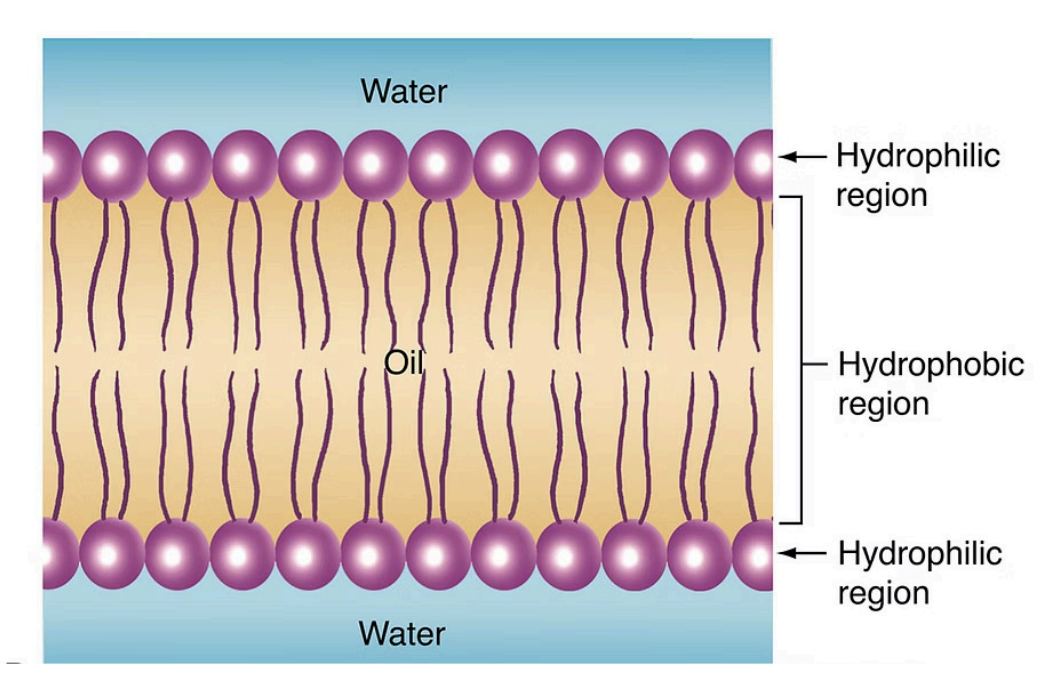
membrane proteins - integral and peripheral proteins embedded in membrane
cholesterol gives fluidity
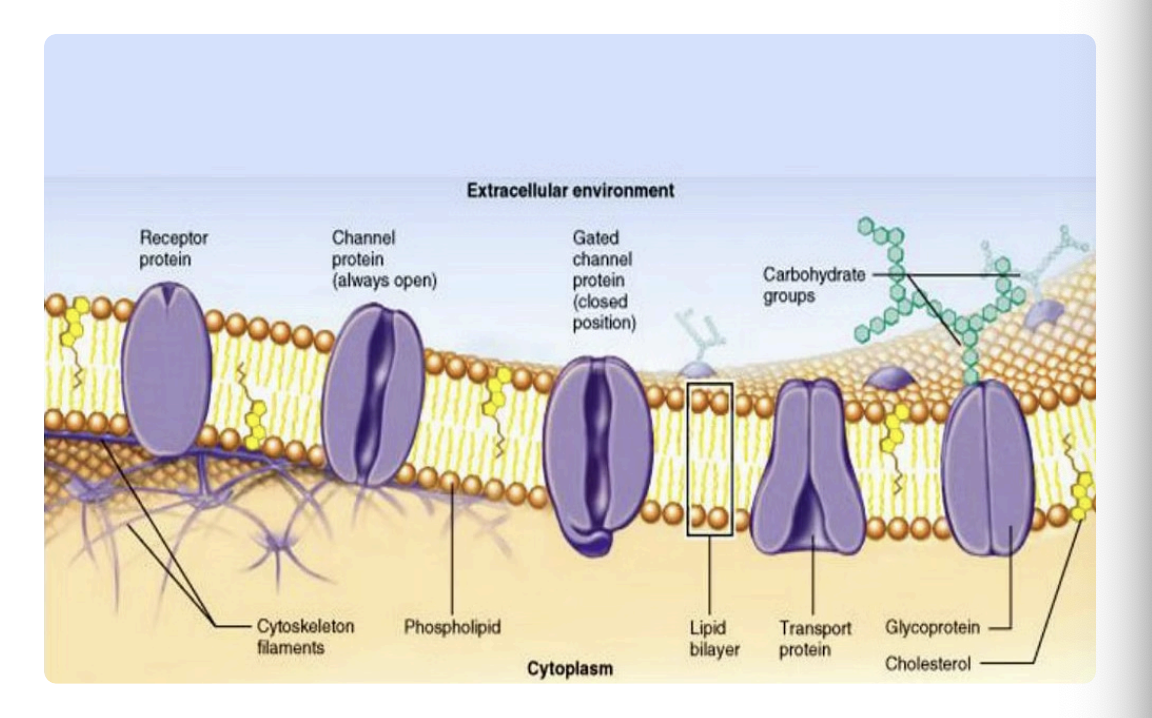
Passive Transport:
Simple Diffusion - small non-polar molecules move down concentration gradient
molecules have no charge
Facilitated Diffusion - carrier proteins help move larger molecules
Osmosis - water diffuses through a semipermeable membrane
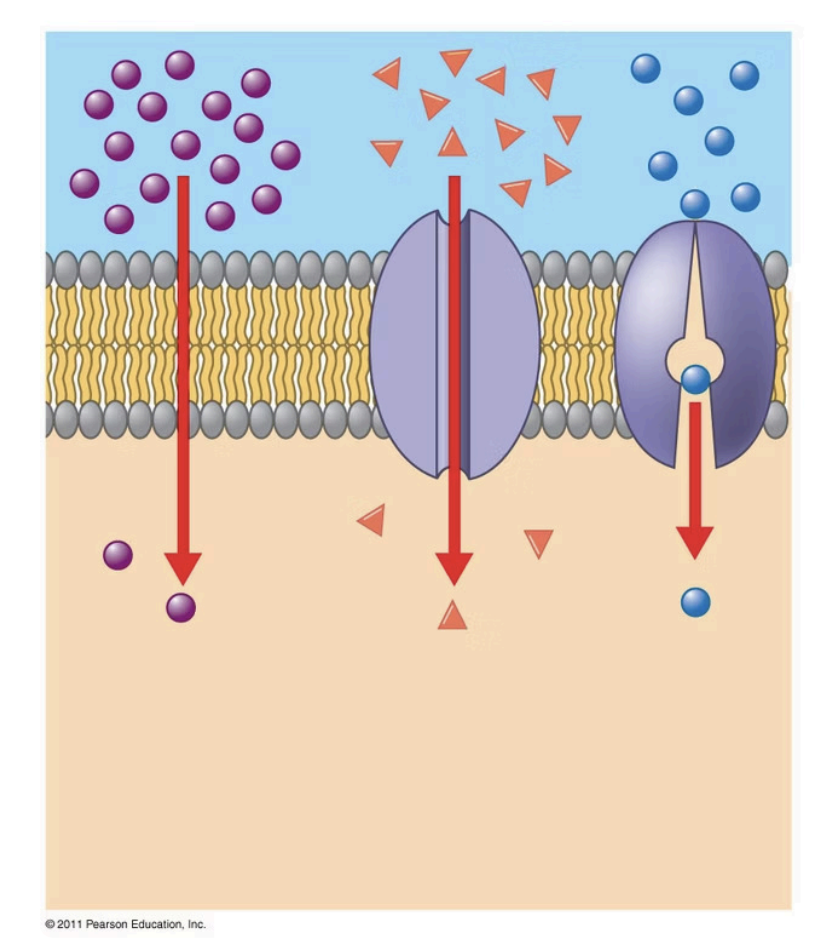
Active Transport:
Sodium-Potassium Pump - uses ATP to move ions against concentration gradient
always a high concentration of sodium outside the cell (at rest)
always a high concentration of potassium in the cell (at rest)
always pushing 3 sodium out and 2 potassium in
Endocytosis - cell engulfs material by forming vesicles
Exocytosis - cell releases material by fusing vesicles with membrane
Cytoplasm and Organelles:
Cytoplasm - cytosol and organelles inside of cell
cytosol
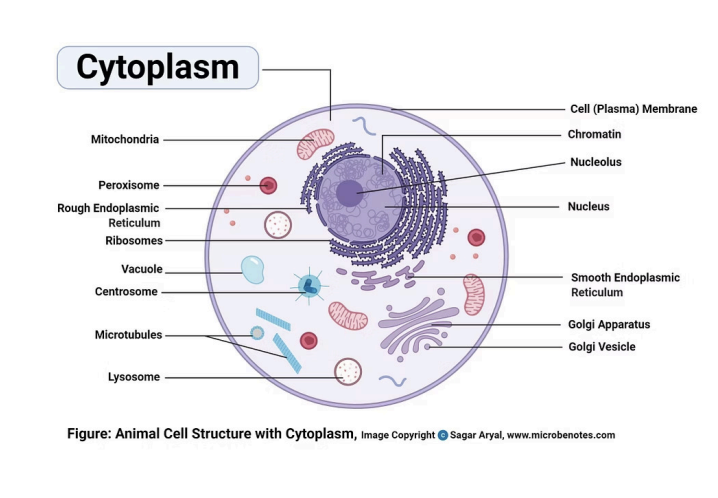
Endoplasmic reticulum - network of membranes for protein and lipid synthesis
rough - proteins
smooth - storage, create lipids
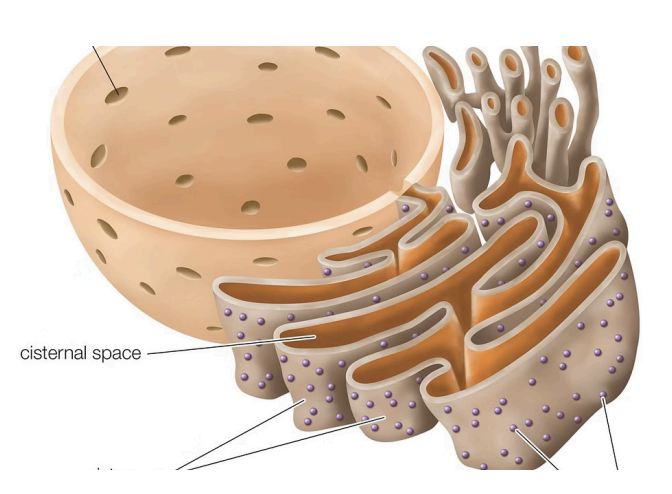
Golgi Apparatus - modifies, packages, and distributes cellular products
Golgi prime
cis - enter
trans - exit
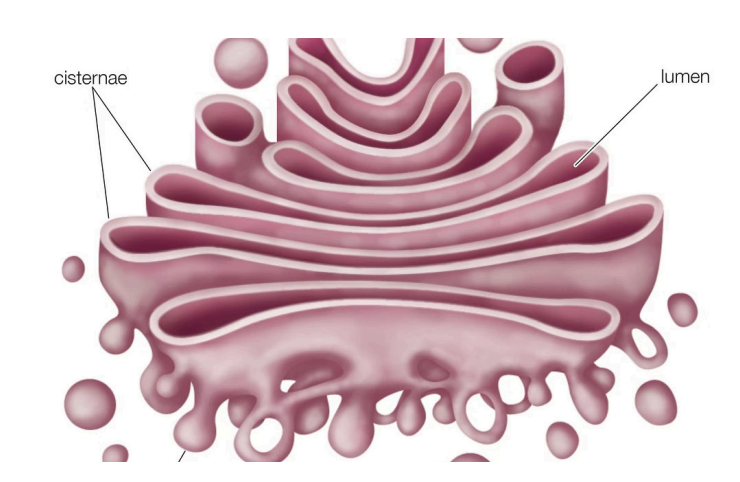
Mitochondria - powerhouses of the cell, produce ATP through respiration
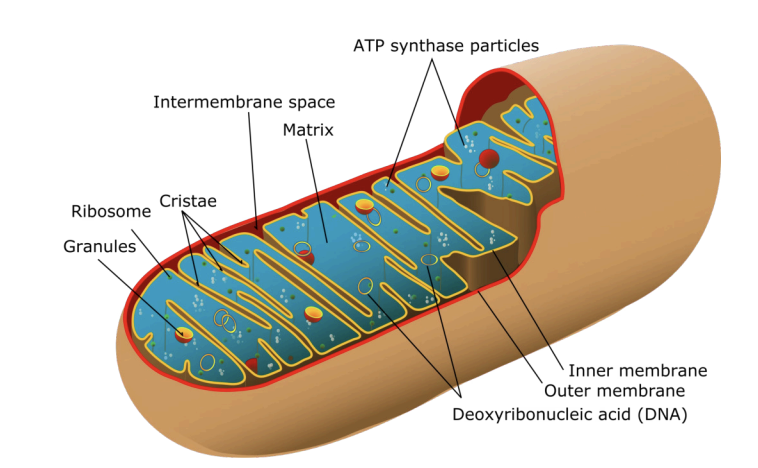
Peroxisomes - break down fatty acids and detoxify harmful substances
crystalline core - peroxide
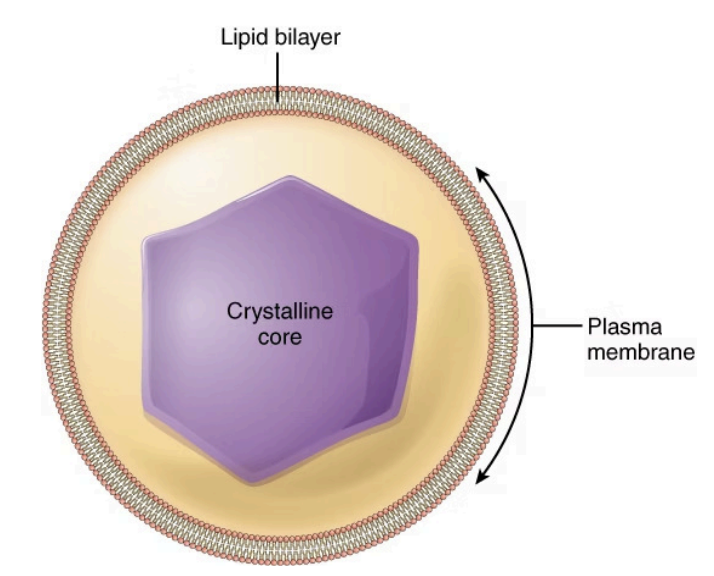
Lysosomes - contains enzymes for breaking down cellular materials
pre-programmed cell death
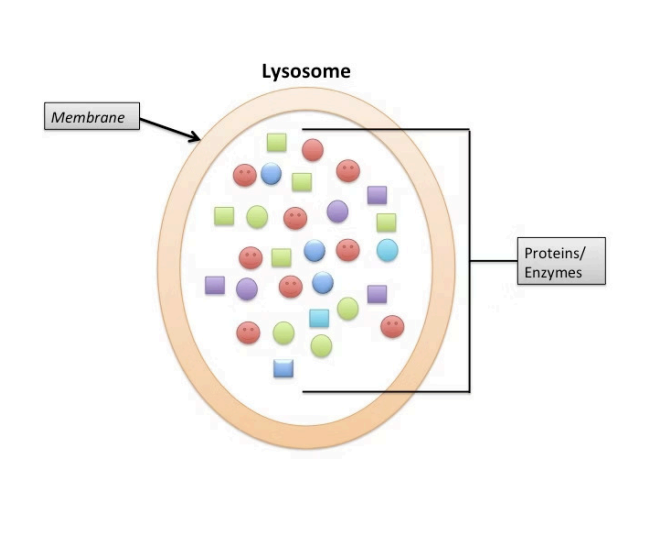
Cytoskeleton - all structural components, cells would have no structure without them
microtubules - provide structure and assist in cell division
intermediate filaments - provide tensile strength to cells
microfilaments - actin filaments involved in cell movement and division
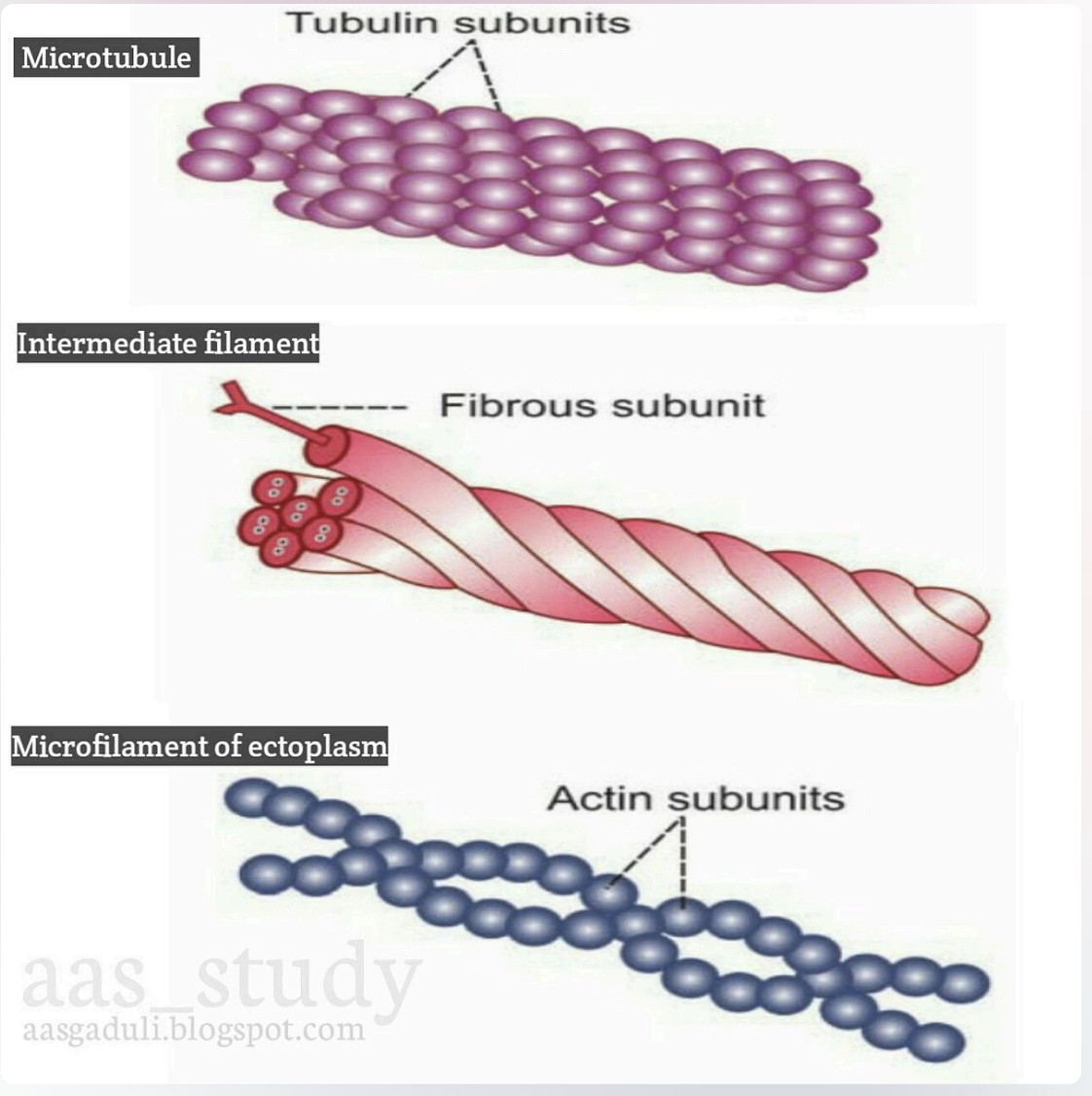
Nucleus
nuclear envelope - double membrane with pores surrounding genetic material
chromatin - DNA and proteins that make up chromosomes
spaghetti
nucleolus - site of ribosome production
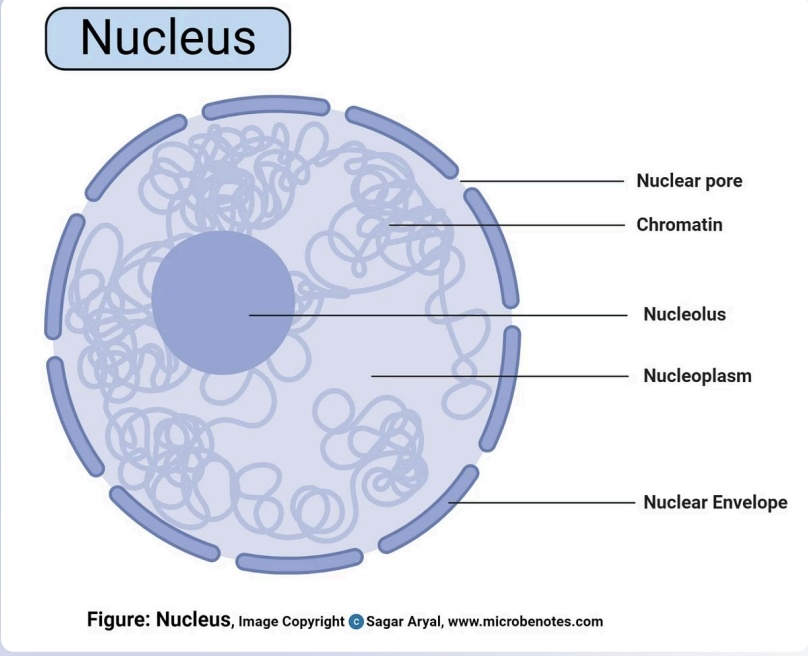
DNA Structure:
double helix - two complementary strands of nucleotides
base pairs - adenine pairs with thymine, cytosine with guanine
at&t
cgi
who discovered DNA (bonus question)
DNA Replication:
initiation - DNA strands separate at origin of replication
helicase - unzips the DNA strand
elongation - new complementary strands synthesized by DNA polymerase
termination - replication complete, yielding two identical DNA molecules
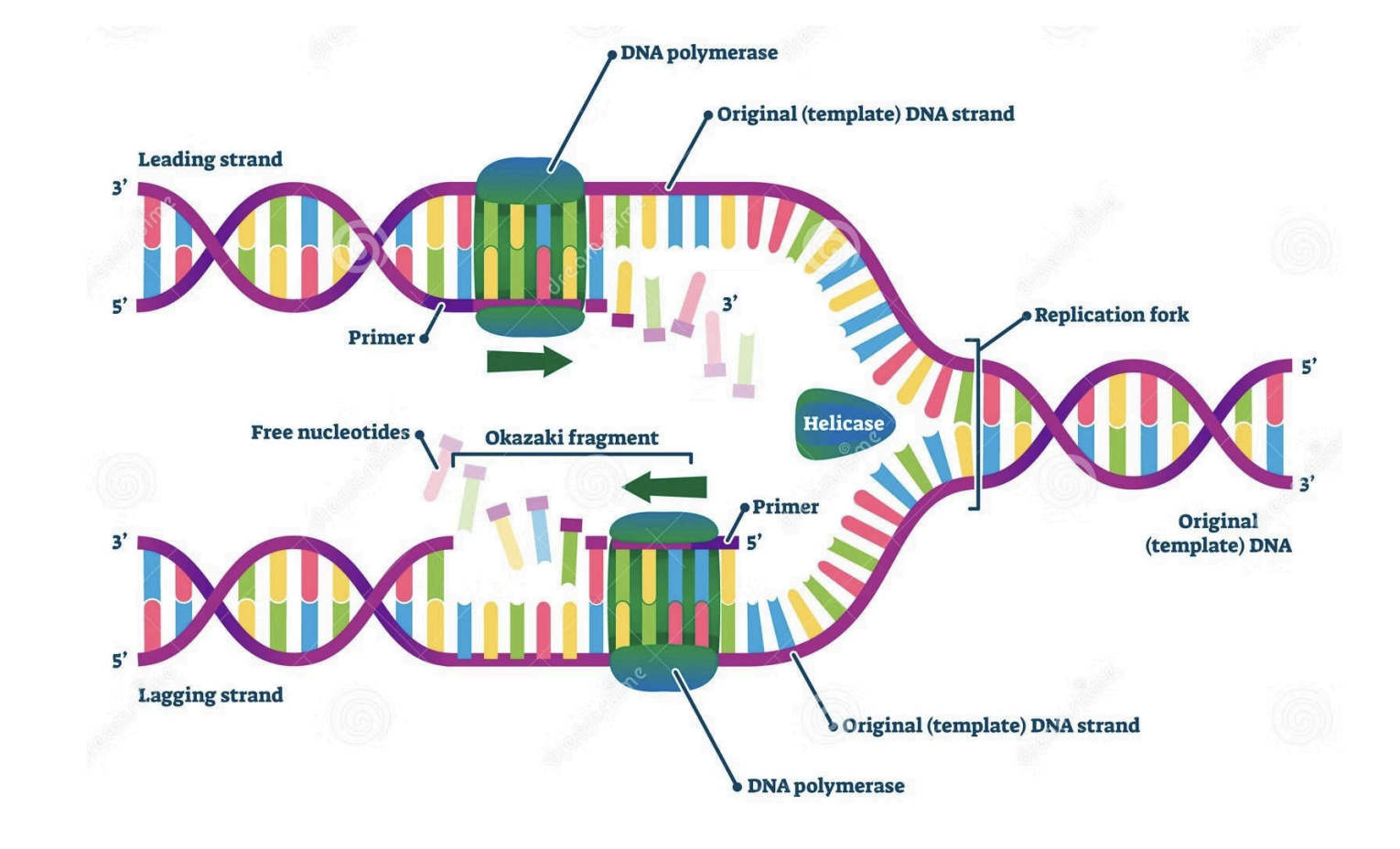
Transcription:
initiation - RNA polymerase binds to DNA promoter region
elongation - RNA strand synthesized complementary to DNA template
termination - RNA polymerase reachers terminator sequence and detaches
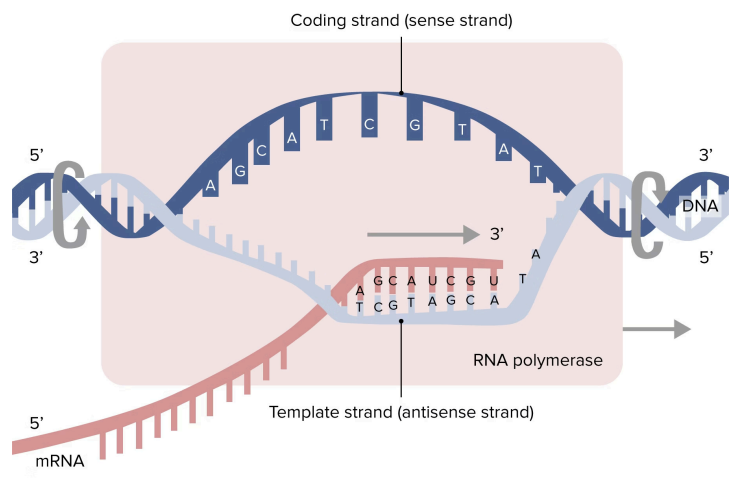
Translation:
initiation - ribosome assembles on mRNA start codon
elongation - amino acids added to growing polypeptide chain
termination - ribosome reaches stop codon, polypeptide released
Cell Cycles:
G1 phase - cell growth and normal metabolic roles
S phase - dna replication occurs
G2 phase - cell prepares for division
protein synthesis
M phase - mitosis and cytokinesis
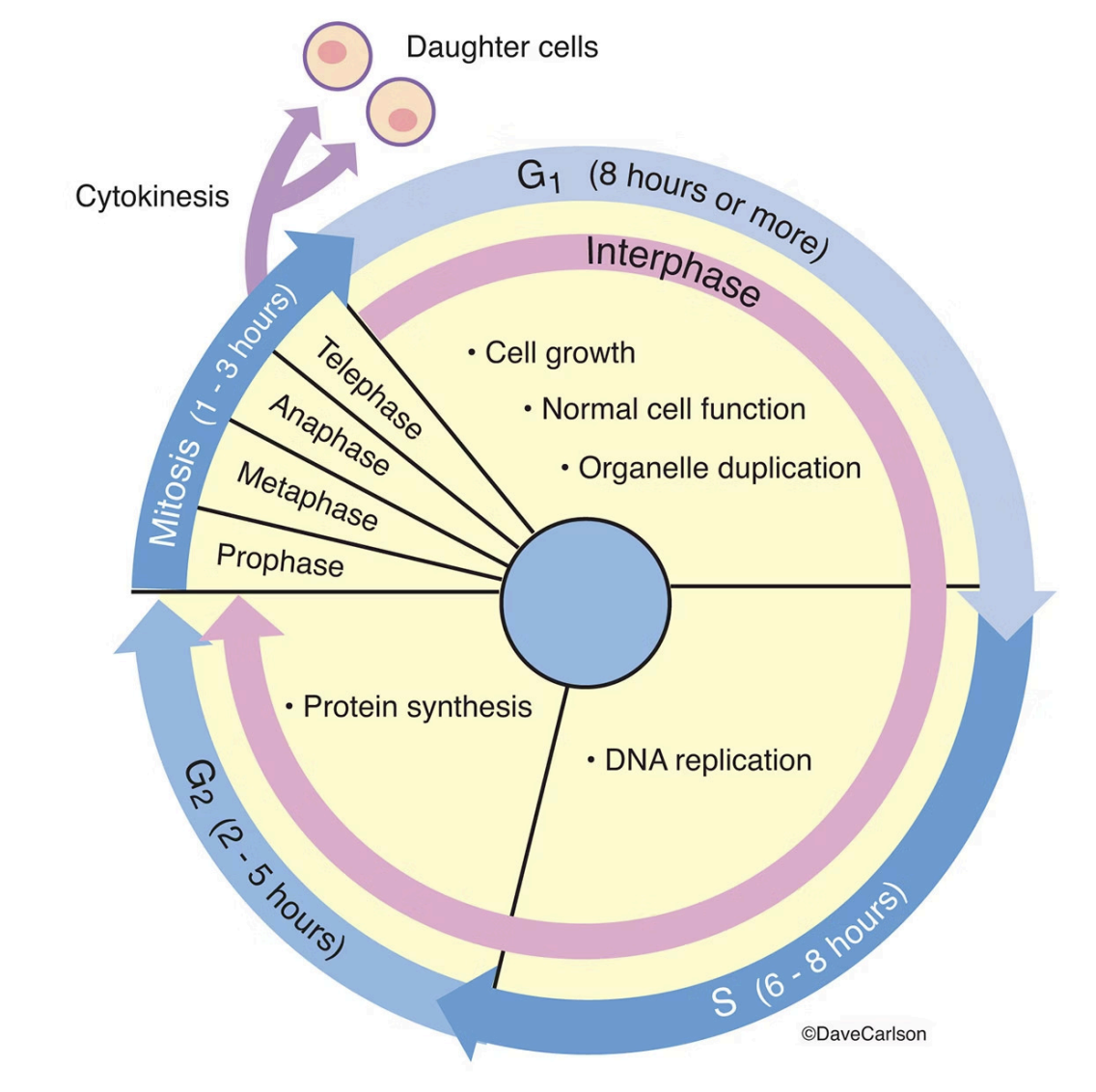
Mitosis:
prophase - chromosomes condense, nuclear envelope breaks down
metaphase - chromosomes align at cell equator
anaphase - sister chromatids separate to opposite poles
telophase - nuclear envelopes reform, chromosomes decondense
cytokinesis - cleavage furrow pinches cell in two
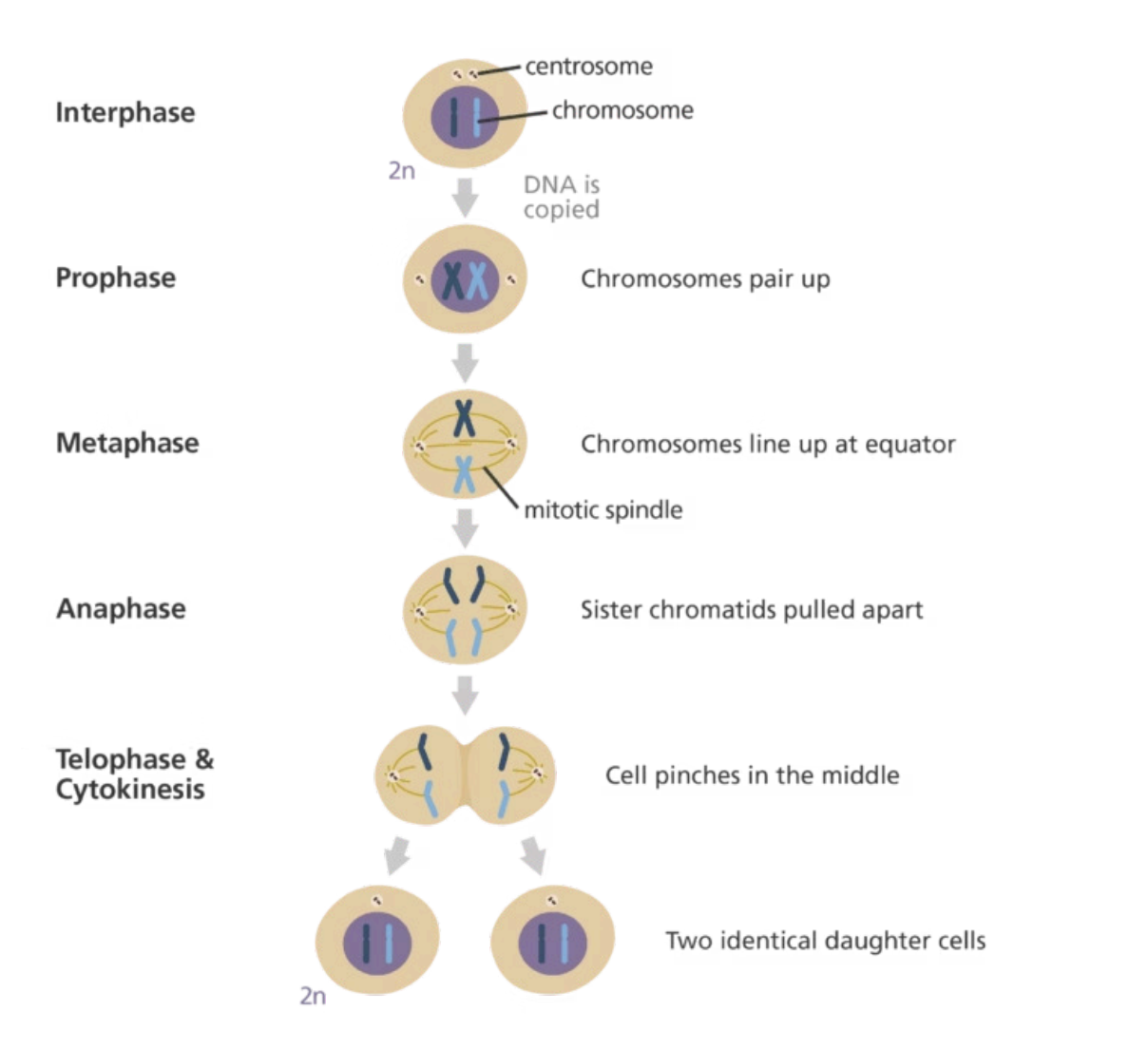
Cancer and the Cell Cycle:
uncontrolled cell division
cells divide excessively and invade other tissues
mutations
changes in genes controlling cell cycle regulation
loss of contact inhibition
cancer cells continue dividing when touching other cells
Stem Cells:
totipotent - can form all cell types
pluripotent - can form most cell types
multipotent - can form multiple cell types
unipotent - can form only one cell types
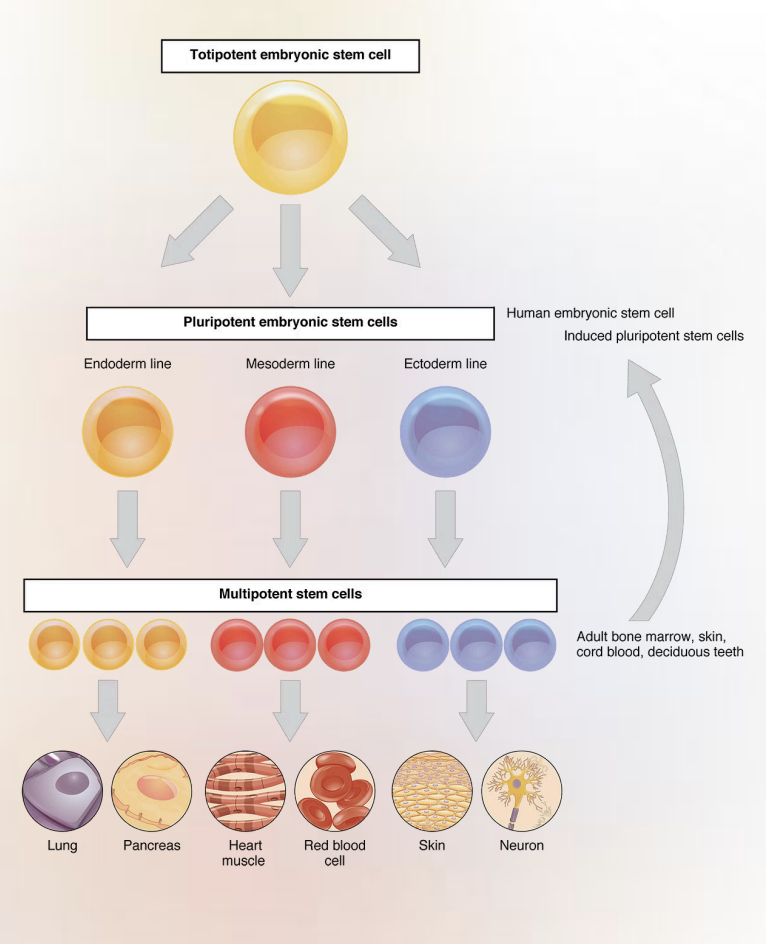
Cell Differentiation:
gene regulation - selective gene expression determine cell specialization
transcription factors - proteins that control which genes are expressed
epigenetic changes - modifications to DNA that affect gene expression
The Tissue Level of Organization
Introduction to Tissues:
cell types - at least 200 distinct cell types in body
organization - cells occur in organized layers called tissues
development - single fertilized egg gives rise to trillions of cells
Types of Tissues:
epithelial - covers surfaces, lines cavities, forms glands
connective - binds, supports, protects body parts
muscle - contracts to provide movement
nervous - transmits electrical signals
Tissue Membrane:
thin layers of cells covering surfaces
functions - protection, secretion, absorption
types - connective tissue and epithelial membranes
Connective Tissue Membranes:
composition
connective tissue
location
encapsulate organs
line movable joints
example
synovial joints
function
produce lubricating synovial fluid
Epithelial Membranes:
composition
epithelium attached to connective tissue
types
mucous, serous, cutaneous
functions
line cavities, protect, secrete
Epithelial Tissue Functions
protection
first line of defense against wear and tear
absorption
selective transfer of materials across barrier
secretion
release mucus and chemical compounds
sensation
contain sensory nerve endings
The Epithelial Cell
polarity
organelles distributed between basal and apical surfaces
specializations
microvilli, cilia on apical surface
function
adapted for protection, absorption, secretion
Cell-to-Cell Junctions:
tight junctions - form seal between adjacent cells
anchoring junctions - mechanically attach cells
desmosomes - side walls
hemidesomosomes - basal side to basement layer
gap junction - allow passage of materials between cells
Types of Epithelial Cells and Examples
simple squamous
lung
stratified squamous
esophagus
simple cuboidal
kidney
stratified cuboidal
sweat gland
simpler columnar
stomach
stratified columnar
salivary duct
pseudo-stratified columnar
trachea
transitional
bladder
Glandular epithelium:
endocrine - ductless glands secreting hormones into blood
exocrine - glands with cuts secreting substances externally
ducts can be tubular, bulbar, or combination
Connective Tissue Functions:
support - provides structural framework for body
protection - cushions and insulates organs
integration - binds organs and tissues together
storage — stores energy in form of fat
Connective Tissue Proper:
diverse group of tissues that connect, support, and protect other tissues and organs
composed of cells, fibers, and a ground substance
ground substance - a gel-like material that fills the spaces between cells and fibers
a medium for the exchange of nutrients and wastes
Cells of Connective Tissue Proper:
fibroblasts - produces the extracellular matrix, the structural framework of connective tissue
macrophages - cells that engulf and digest debris, pathogens, and foreign materials
mast cells - release histamine, causing inflammation and allergic reactions
adipocytes - fat cells store energy, insulate, and cushion organs
Fibers of Connective Tissue Proper:
provide strength, elasticity, and support
collagen - strong and flexible, providing tensile strength
elastic - stretchy and allow tissues to return to their original shape
reticular - thin and branching, forming delicate networks that support other tissues
Types of Connective Tissue:
loose - flexible, with space between fibers
adipose, areolar, reticular
dense - tightly packed fibers
tendons, ligaments
specialized - unique properties
cartilage, bone, fluid
Loose Connective Tissue:
areolar connective tissue - areolar tissue is a flexible, web-like tissue with a variety of cell types
adipose connective tissue - consists mainly of adipocytes, which store energy as fat
reticular connective tissue - forms a framework for organs like the spleen and lymph nodes
Dense Connective Tissue:
Dense regular - tightly packed, parallel collagen fibers, providing high tensile strength
tendons
ligaments
dense irregular - collagen fibers arranged in a more irregular pattern, provide strength in multiple directions
dermis of skin
capsules surround organs
elastic - more elastic fibers than collagen fibers, allowing it to stretch and recoil
walls of blood vessels
lungs
Cartilage Connective Tissue:
hyaline cartilage - most common, reduces friction in joints and provides support
joints
trachea
elastic cartilage - more flexible than hyaline cartilage due to elastic fibers
ear
nose
fibrocartilage - strongest type with a high density of collagen fibers
intervertebral discs
menisci
Specialized Connective Tissue:
bone tissue - provides support, protection, and movement
specialized cells produce a hard, mineralized matrix
blood and lymph - fluid connective tissues that transport gases, nutrients, and waste products throughout the body
Muscle Tissue:
skeletal - striated, voluntary
body movement
cardiac - striated, involuntary
heart contraction
smooth - non-striated, involuntary
organ movement
Nervous Tissue:
neurons - conduct electrical signals
glial cells - support and protect neurons
function - information processing and response
Tissue Aging:
skin changes
thinner, less elastic, wrinkles form
muscle loss
decreased mass and strength
bone weakening
lower mineral density, increased fracture risk
slower healing
reduced capacity for tissue repair